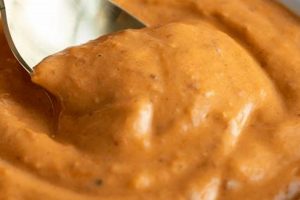A plant-based condiment, this flavorful mixture replicates the tangy and sugary profile of a classic accompaniment, omitting animal-derived ingredients. Common variations incorporate pineapple juice, rice vinegar, tomato paste, and a sweetener like maple syrup or agave. This combination creates a vibrant dipping sauce suitable for plant-based proteins and vegetables.
Choosing a version free from animal products aligns with ethical and dietary preferences, offering a versatile alternative for individuals seeking to reduce their consumption of animal-based foods. Its adaptability allows for diverse culinary applications, and its accessibility makes it a convenient option for both home cooks and food service establishments. The history of such preparations reflects a broader trend towards inclusive and customizable cuisine.
The ensuing discussion will explore the formulation, preparation methods, common uses, and nutritional considerations pertaining to the aforementioned plant-based condiment. A comprehensive analysis will highlight its role in contemporary vegan cuisine, exploring aspects of sourcing ingredients and customizing flavor profiles.
Enhancing the Plant-Based Condiment Experience
The following recommendations are designed to optimize the preparation, utilization, and preservation of a plant-based condiment with a distinct sweet and tangy flavor profile.
Tip 1: Ingredient Quality Matters. Prioritize fresh, high-quality ingredients, particularly pineapple juice, to achieve a vibrant and authentic flavor. Canned pineapple juice may introduce a metallic taste, impacting the final product.
Tip 2: Acidity Balance is Key. Carefully adjust the ratio of vinegar to sweetener. Rice vinegar provides a milder acidity, while apple cider vinegar offers a more robust tang. The choice should complement the desired flavor intensity.
Tip 3: Thicken Strategically. Cornstarch, arrowroot powder, or tapioca starch can effectively thicken the condiment. Create a slurry with cold water before adding it to the sauce to prevent clumping.
Tip 4: Controlled Sweetness Levels. Opt for natural sweeteners like maple syrup or agave. Begin with a conservative amount and gradually adjust to personal preferences, considering the natural sweetness of other ingredients like pineapple.
Tip 5: Enhance with Umami. Incorporate a source of umami, such as tamari or mushroom powder, to add depth and complexity to the flavor profile. This balances the sweetness and acidity, creating a more satisfying taste.
Tip 6: Freshness Preservation. Store the finished condiment in an airtight container in the refrigerator. Properly stored, it can maintain its quality for up to one week.
Tip 7: Culinary Versatility. This condiment is not limited to dipping. Experiment with it as a glaze for roasted vegetables, a marinade for tofu, or an addition to stir-fries for a burst of flavor.
Adhering to these suggestions promotes a more flavorful, versatile, and stable plant-based condiment suitable for diverse culinary applications.
The subsequent sections will address frequently asked questions and explore potential variations in recipes, further expanding on the practical aspects of incorporating this plant-based condiment into a balanced dietary regime.
1. Flavor Profile
The flavor profile is the defining attribute of any culinary creation, and in the specific context of a plant-based sweet and sour sauce, it dictates consumer perception and acceptance. A successful flavor profile necessitates a harmonious balance between sweet, sour, and, often, savory or umami elements. The absence or overabundance of any single component can render the sauce unpalatable. For example, an insufficient sour element will result in a cloying sweetness, while excessive acidity overwhelms the other nuances. The effective replication of a traditional, non-vegan counterpart hinges on a nuanced understanding of these interactions, particularly when substituting animal-derived components with plant-based alternatives.
The creation of a desirable flavor profile involves careful selection and calibration of ingredients. Plant-based sources of sweetness, such as agave nectar or maple syrup, possess distinct flavor characteristics that influence the final outcome. Similarly, different vinegars, like rice vinegar or apple cider vinegar, offer varying degrees of acidity and subtle flavor notes. Beyond sweetness and acidity, the inclusion of ingredients like soy sauce (tamari for gluten-free versions) or mushroom powder provides a depth of umami, enhancing the complexity and overall satisfaction. The order in which ingredients are introduced and the duration of simmering significantly influence the final flavor profile. For instance, lightly caramelizing tomato paste before adding liquid components can intensify its sweetness and deepen its savory notes.
Ultimately, the flavor profile is the core around which a successful version of this sauce is built. While plant-based substitutions may present formulation challenges, a meticulous approach to ingredient selection, balance, and cooking technique can yield a compelling and flavorful outcome. The understanding of flavor profiles is not just academic but practically essential for creating a sauce that is both ethically aligned and gastronomically satisfying. The successful implementation of plant-based ingredients in a flavorful way enhances the appeal of vegan cuisine, widening its acceptance among diverse consumer groups.
2. Ingredient Substitution
Ingredient substitution forms a cornerstone of plant-based cuisine, particularly in replicating established dishes. In the context of plant-based sweet and sour sauce, this practice is not merely an option but a necessity. Traditional recipes often include honey or other animal-derived components, thus necessitating direct replacements to achieve a comparable, yet plant-based, product. The selection of suitable substitutes has a direct and significant impact on the final flavor, texture, and overall appeal of the plant-based sauce. For example, substituting honey with agave nectar introduces a different sweetness profile, potentially altering the acidity balance. Similarly, alternatives to conventional thickeners, such as gelatin, are crucial in achieving the desired viscosity. Ineffective substitution can lead to an inferior product, lacking the characteristic qualities of the original.
The importance of ingredient substitution extends beyond simple replacement. It necessitates an understanding of the functional properties of each ingredient and how those properties can be mimicked using plant-based alternatives. For instance, using fruit purees or concentrates can replace honey, not only adding sweetness but also contributing to the body and texture of the sauce. Similarly, incorporating vegetable stock enhances the savory notes, compensating for the absence of animal-based broths. A pragmatic approach involves meticulous experimentation with ingredient ratios and cooking techniques to achieve optimal results. Real-world examples include recipes employing pineapple juice to intensify sweetness, coupled with rice vinegar to replicate the characteristic sourness. The deliberate inclusion of umami-rich ingredients like tamari or mushroom powder further enhances the depth of flavor.
In conclusion, ingredient substitution is paramount in creating a successful plant-based sweet and sour sauce. It requires a thorough understanding of both traditional culinary principles and the unique characteristics of plant-based ingredients. The challenge lies in achieving an authentic flavor profile while adhering to ethical and dietary restrictions. Mastering ingredient substitution not only ensures the creation of a palatable plant-based sauce but also contributes to the broader acceptance and appreciation of plant-based cuisine as a whole. Further research and experimentation will continue to refine this process, expanding the possibilities for plant-based alternatives in various culinary applications.
3. Thickening Agents
The viscosity of plant-based sweet and sour sauce is significantly influenced by the selection and application of thickening agents. These ingredients play a crucial role in achieving a desirable texture, impacting both the sensory experience and the sauce’s ability to adhere to food items. Without appropriate thickeners, the sauce may lack body and separation might occur, diminishing its overall appeal.
- Cornstarch
Cornstarch is a common and readily available thickening agent derived from corn. It functions by gelatinizing in the presence of heat and liquid, creating a stable colloidal dispersion that increases viscosity. However, excessive use of cornstarch can result in a cloudy appearance. In the context of plant-based sweet and sour sauce, a slurry of cornstarch and cold water is typically added towards the end of the cooking process to achieve the desired thickness. Overheating cornstarch after gelatinization can cause it to break down, reducing its thickening power.
- Tapioca Starch
Tapioca starch, derived from the cassava root, offers an alternative thickening mechanism. It provides a glossy, almost translucent finish, which may be aesthetically preferred over cornstarch in certain applications. Tapioca starch thickens at a lower temperature than cornstarch. However, it is more susceptible to thinning if subjected to prolonged high heat or acidic conditions. When used in plant-based sweet and sour sauce, careful monitoring of temperature and cooking time is crucial to maintain the desired consistency.
- Arrowroot Powder
Arrowroot powder, extracted from the arrowroot plant, offers a neutral flavor profile and produces a clear, glossy finish. It is considered a good option for individuals with corn sensitivities. Like tapioca starch, arrowroot is susceptible to breaking down under prolonged heat and acidity. Its application in plant-based sweet and sour sauce requires careful attention to temperature control. Its often favored when clarity of the sauce is paramount.
- Modified Food Starch
Modified food starches are starches that have been chemically or physically altered to enhance their functional properties, such as thickening power, stability, or texture. Various types of modified food starches are available, each with specific characteristics. These starches can offer advantages like improved resistance to heat, acid, or shear stress, making them suitable for commercial production of plant-based sweet and sour sauce. However, the use of modified food starches may raise concerns among consumers seeking natural or minimally processed ingredients, influencing product labeling and marketing strategies.
The selection of an appropriate thickening agent for plant-based sweet and sour sauce depends on various factors, including desired texture, appearance, stability, and consumer preferences. Careful consideration of the properties of each thickening agent is essential to achieve a palatable and aesthetically pleasing end product. The interplay between thickening agent, acidity, and heat requires precise calibration for optimal results, furthering the pursuit of a successful plant-based condiment.
4. Acidity Regulation
Acidity regulation constitutes a critical element in the formulation of plant-based sweet and sour sauce. The tartness characteristic of this condiment arises from acidic components, typically derived from vinegars or fruit juices. Imprecise acidity levels can lead to an unbalanced flavor profile, rendering the sauce either excessively tart or excessively sweet, thereby detracting from its palatability. The selection of the acidic agent, its concentration, and its interaction with other ingredients directly impact the final taste and overall acceptance of the sauce. For instance, an overabundance of rice vinegar, while contributing acidity, may impart an unwanted sharp flavor, whereas an insufficient quantity fails to provide the signature tang. Therefore, careful regulation of acidity is not merely an aesthetic consideration but a fundamental aspect of achieving a harmonious flavor profile in plant-based sweet and sour sauce.
Practical application of acidity regulation involves meticulous control over ingredient ratios and precise measurement techniques. Recipes commonly specify the type and quantity of acidic components, such as rice vinegar, apple cider vinegar, or lemon juice. The choice of acidic agent influences the resulting flavor nuances; for example, rice vinegar offers a milder tartness compared to the more pronounced acidity of apple cider vinegar. In some instances, the pH level of the sauce can be assessed using pH meters or test strips to ensure consistency and replicability across batches. Adjustments to acidity can be made by gradually adding small increments of the acidic agent or by incorporating neutralizing ingredients, such as sweeteners or alkaline components. Understanding the specific properties of each acidic ingredient and its interaction with other components within the sauce is essential for achieving a well-balanced flavor.
In summary, acidity regulation is an indispensable aspect of formulating palatable plant-based sweet and sour sauce. Its influence on the flavor profile necessitates meticulous control over ingredient ratios, precise measurement techniques, and a thorough understanding of the acidic components’ properties. The challenges associated with achieving a harmonious flavor profile underscore the importance of careful experimentation and iterative adjustments. Ultimately, successful acidity regulation results in a plant-based sauce that delivers the characteristic sweet and tangy experience, fulfilling consumer expectations and contributing to the versatility of plant-based cuisine.
5. Shelf Stability
Shelf stability, in the context of plant-based sweet and sour sauce, refers to the sauce’s ability to resist spoilage and maintain acceptable quality attributes such as flavor, color, texture, and safety over an extended period under defined storage conditions. The inherent characteristics of plant-based ingredients, coupled with the absence of animal-derived preservatives commonly found in traditional formulations, present unique challenges to achieving adequate shelf stability. Microbial growth, enzymatic activity, and oxidation reactions are key factors that can degrade the sauce’s quality, impacting its sensory appeal and potentially posing health risks. For instance, sauces prepared with fresh fruit purees, without appropriate preservation techniques, exhibit a shorter shelf life compared to those utilizing commercially processed, shelf-stable fruit components. Consequently, understanding the factors influencing degradation and implementing appropriate preservation strategies are crucial for extending the usability and commercial viability of plant-based sweet and sour sauce.
The primary methods for enhancing the shelf stability of plant-based sweet and sour sauce involve controlling microbial growth and mitigating chemical reactions. Heat treatment, such as pasteurization or sterilization, reduces the microbial load and inactivates enzymes responsible for degradation. Acidification, achieved through the addition of vinegar or other acidic ingredients, lowers the pH, inhibiting the growth of many spoilage microorganisms. The inclusion of preservatives, such as potassium sorbate or sodium benzoate, further restricts microbial activity. Packaging plays a critical role in preventing contamination and oxidation; airtight containers, particularly those made of materials with low oxygen permeability, are essential for maintaining product quality. Examples include using a hot-fill-hold technique where the sauce is heated, filled into sterilized jars, sealed, and held at a specific temperature for a set time to ensure proper pasteurization. Commercial producers of plant-based sauces often employ advanced packaging technologies, such as modified atmosphere packaging (MAP), to extend shelf life.
In conclusion, shelf stability is a critical parameter for plant-based sweet and sour sauce, influencing its marketability and consumer acceptance. Achieving extended shelf life necessitates a multi-faceted approach, encompassing careful ingredient selection, appropriate processing techniques, effective preservation strategies, and suitable packaging solutions. The ongoing development of innovative preservation technologies and plant-based ingredients will likely contribute to further improvements in the shelf stability and overall quality of these sauces. A lack of attention to shelf stability can result in product spoilage, consumer dissatisfaction, and potential economic losses. Therefore, a comprehensive understanding of shelf stability principles is essential for formulators and manufacturers of plant-based sweet and sour sauces.
Frequently Asked Questions
The following questions and answers address common concerns and provide clarity regarding plant-based sweet and sour sauce.
Question 1: What differentiates plant-based sweet and sour sauce from traditional variations?
Plant-based formulations exclude animal-derived ingredients such as honey or animal-based stocks, relying instead on plant-based sweeteners and vegetable broths to achieve a comparable flavor profile.
Question 2: Is plant-based sweet and sour sauce nutritionally equivalent to traditional versions?
Nutritional profiles may vary based on ingredient selection. Plant-based versions often contain less sodium and cholesterol, but carbohydrate content may be similar. Reviewing nutrition labels is advisable.
Question 3: Can plant-based sweet and sour sauce be used interchangeably with traditional versions in recipes?
In most cases, yes. The flavor and texture are designed to closely mimic traditional sauces, making them suitable for direct substitution in various culinary applications.
Question 4: What are the common plant-based sweeteners used in these sauces?
Agave nectar, maple syrup, and cane sugar are frequently employed as plant-based alternatives to honey, each contributing a slightly different flavor nuance.
Question 5: How does shelf-life compare between plant-based and traditional sweet and sour sauces?
Shelf-life depends on preservation methods. Commercially produced versions often have comparable shelf lives due to pasteurization and preservatives. Homemade versions typically have a shorter shelf life and require refrigeration.
Question 6: Are there allergen considerations specific to plant-based sweet and sour sauce?
Potential allergens depend on ingredients. Soy-based sauces (using tamari) and fruit-based components should be considered by individuals with relevant allergies.
In essence, plant-based sweet and sour sauce offers a viable alternative to traditional versions, accommodating dietary preferences and ethical considerations. Understanding the nuances of ingredients and formulation is crucial for informed consumption.
The subsequent section will delve into specific recipe variations and customization options for plant-based sweet and sour sauce.
Conclusion
The preceding exploration has illuminated the multifaceted aspects of “vegan sweet and sour sauce,” encompassing formulation, ingredient substitution, and factors influencing stability. It is evident that crafting a palatable and shelf-stable product necessitates a comprehensive understanding of culinary principles and ingredient functionalities. Considerations range from flavor profile optimization to meticulous control over acidity and microbial activity.
The evolution of “vegan sweet and sour sauce” reflects a broader trend towards inclusive and ethically conscious cuisine. Continued research and refinement in plant-based ingredient technology promise further advancements in flavor, texture, and shelf life. The ongoing commitment to these improvements will likely contribute to the expanding adoption and appreciation of plant-based culinary options.







